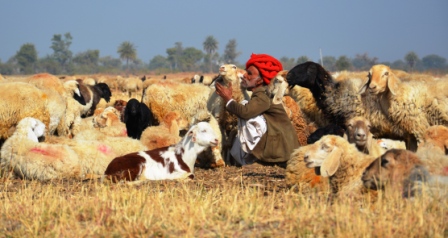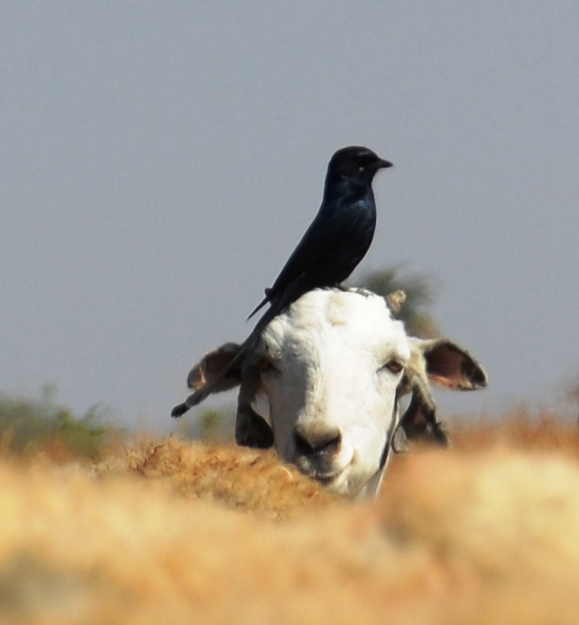We – Hanwant Singh (director of LPPS), Raika leader Dayalibai, and I – just returned from a visit to a group of migrating shepherds – locally referred to as dang – which had set up their temporary camp somewhere between Udaipur and Chittorgarh (in southern Rajasthan). It was an enlightening experience and a lesson in sustainable, eco-friendly animal husbandry that is quite profitable to boot. But an easy life it is not! For 8 months out of the year these people are on the move, only for the four months of the rainy season do they return to their villages. For the rest of the year, men, women and small children, are out of doors and subjected to the vagaries of the climate, without even making use of tents. But, for all those who think this way of life is anachronistic and passé: While our hosts complained a lot about dangers from theft and increasing harassment from villagers, they uniformly agreed that this way of life was more than a rung above working in Mumbai sweatshops or doing unskilled labour.
This particular herding group was composed of 6 nuclear families with a couple of thousand sheep and they move every few days, grazing their herds almost entirely on fallow land, cultivated with jowar and ajwein. All decisions of the dang are made by an elected leader, the patel, who is in charge of negotiating with land owners, police and all outside agencies, so spends much time nurturing contacts and sorting out disputes. But the rest of the chores ares done in teamwork , with everybody having an assigned role. The adult sheep are taken out to graze early in the morning before sunrise, at about 6 a.m., return at around 10 a.m., then rest for a few hours, before again going out to feed until after sunset. The young lambs are tied up in loops, allowed to drink when the mothers return from their feeding sorties. What a noisy event – there’s a cacophony of bleating when thousands of ewes are trying to connect with their very own lamb and the shepherds are busy for about an hour carrying around lambs and enabling them to suckle their meals from their own mums and not any other lactating sheep!
The sheep and a much smaller herd of goats were all in very good condition, with clean coats and clear eyes, despite just having weathered an outbreak of Foot and Mouth disease which is doing the rounds currently. They were in much better shape, and are also much more productive and profitable than those kept in sedentary conditions.
The cast was completed by 8 camels for carrying the luggage, as well as around a dozen donkeys that also do their share in transporting household goods. Plus associated wildlife – a herd of nilgai was roaming around, small flocks of drongos were taking a ride on sheeps’ backs or even frequently perching on the heads of goats.
One could go on waxing away about harmony between people and animals, but more significant in this day and age when there are worries about how to feed people (especially with meat), how to do this sustainably, and how to increase “natural resource use efficiency” (see www.livestockdialogue.org), is probably the ecology and economy of this type of animal husbandry. What strikes me is that these mobile shepherds basically create food out of resources that would otherwise go entirely to waste or not be used. They only use what is left over from crop cultivation and metabolize it into arrange of products, thereby adding enormous value. From a herd of 250-300 sheep, they sell around 50 animals per year for meat. (As mutton is not popular in northern India – here people only want goat meat – it is likely exported to the Middle East.) They also milk the sheep and make ghee and/or curd from it which forms no small part of their diet. And they produce copious amounts of organic fertilizer – a significant feat when alarm is starting to build about the world’s depleting phosphorous resources! This fertilizer is also very much appreciated by some of the land owners who reward the dang with 80 kg of wheat or another grain for every night they spend on their field, in addition to 2 kg of sugar and 250 g of tea leaves.
How much longer is this demanding, but rewarding food production system going to continue? That’s a question that we can’t answer at the moment, but we will try to make monthly visits to the dang to better understand the trials, tribulations and comparative advantages of this way of life.



 Follow
Follow
it is very true that good shepherds are successful livestock keepers. In our language Pashtu, it is saying that; livestock does not from the scarcity of feed but by the poor technical shepherd.